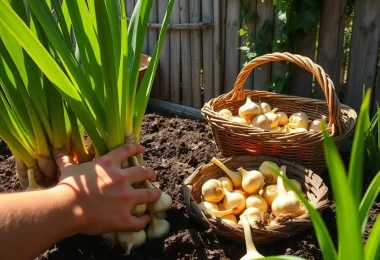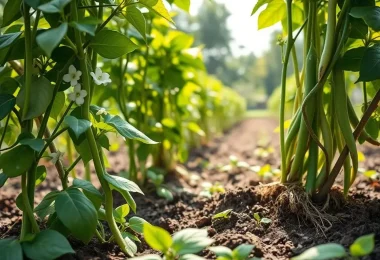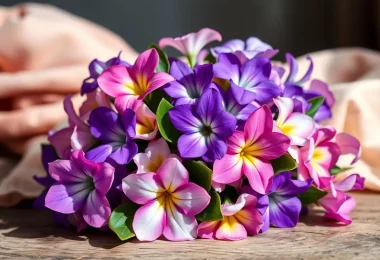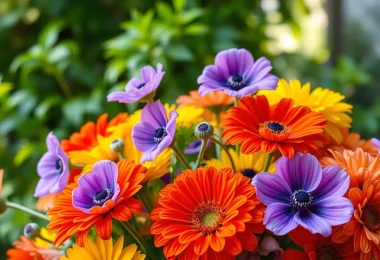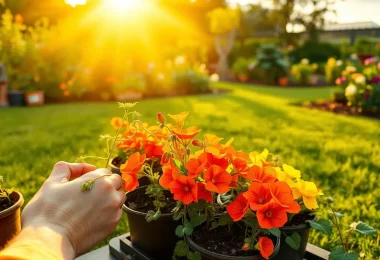Alstroemeria, or the Peruvian lily, is a vibrant flower that brightens any garden or indoor space. This guide is for both seasoned gardeners and beginners. It offers expert tips and techniques for growing and caring for these beautiful blooms.

Key Takeaways
- Alstroemeria is a hardy, long-lasting flower with a wide range of colours and varieties
- Proper site selection and soil preparation are crucial for successful alstroemeria cultivation
- Watering requirements and fertilisation regimes are important to maintain the health of alstroemeria plants
- Pruning and deadheading can prolong the flowering season and keep alstroemeria looking their best
- Overwintering and propagation techniques can help you enjoy alstroemeria year after year
What is Alstroemeria?
Alstroemeria, also known as the Peruvian lily, is a vibrant flowering plant from South America. It’s famous for its unique, asymmetrical petals and long-lasting cut flowers. This makes it a favourite for bouquets and floral arrangements.
related: How to Grow and Care for Alstroemeria: Tips for Success
Introducing the Vibrant Alstroemeria Flower
Alstroemeria flowers are a rainbow of colours, from bright reds and oranges to soft pastels and bold bi-colours. Their petals often have detailed patterns and stripes. These plants grow 50 to 100 centimetres tall, producing clusters of flowers that last for weeks.
The Origin and History of Alstroemeria
The alstroemeria was named after Swedish botanist Clas Alströmer, who brought them to Europe in the 18th century. Found in the Andes mountains of South America, they have a rich history. Today, thanks to selective breeding, there are many varieties of these beautiful flowers.
“Alstroemerias are truly a sight to behold, with their vibrant colours and unique, asymmetrical blooms. These flowers have a rich history and continue to captivate gardeners and floral enthusiasts alike.”
Choosing the Right Alstroemeria Variety
Choosing the right alstroemeria is key for a beautiful garden. The “Peruvian lily” has many varieties, each with its own look and needs. Let’s look at the options to find the best alstroemeria for you.
Think about your climate when picking an alstroemeria. Some love cooler weather, while others prefer it warmer. For example, ‘Rock and Roll’ alstroemeria can handle -15°C, great for cold areas. But ‘Summer Romance’ needs warmer weather and might not do well in harsh winters.
The colour and how long the blooms last are also important. Alstroemerias come in many colours, from bright reds to soft pastels. Some, like ‘Statoil‘, have long-lasting flowers. Others, like ‘Sweet Laura’, grow compactly.

Also, consider the plant’s height and how it grows. Taller ones, like ‘Tutti Frutti’, might need support. Shorter ones, like ‘Little Miss’, are perfect for small spaces or containers.
Choosing an alstroemeria is a personal choice. It depends on your climate, what you like, and where you’re growing. By looking at the special traits of each variety, you can pick the best one for your garden or bouquets.
Planting Alstroemeria
Planting alstroemeria, the vibrant and long-lasting flowers, needs careful thought. You must choose the right spot and prepare the soil well. These tips will help you grow a beautiful alstroemeria patch in your garden.
Site Selection and Soil Preparation
Alstroemerias love well-drained, rich soil that’s slightly acidic. The pH should be between 6.0 and 7.0. Pick a spot that gets full sun, as they need at least six hours of direct sunlight daily.
Don’t plant in heavy clay or compacted soil. It can cause poor drainage and root rot.
Start by digging the soil 8-10 inches deep. Mix in compost or well-rotted manure. This will make the soil better and give your alstroemerias the nutrients they need.
When to Plant Alstroemeria
The best time to plant alstroemerias depends on your local weather. Spring or autumn are usually the best times. In mild winters, plant in autumn to let the roots grow before spring.
In colder areas, spring planting is better. This way, the plants can grow before the hot summer.
When planting, space the rhizomes or tubers 12-18 inches apart. Plant them 4-6 inches deep. Water the soil gently after planting. Keep watering until the plants are strong.

“Alstroemerias are a true delight in the garden, rewarding the careful gardener with a stunning display of vibrant blooms year after year.”
Caring for Alstroemeria Plants
Looking after alstroemeria plants right is key for their health and life span. It’s important to water them properly to keep them looking their best.
Watering Requirements
Alstroemeria plants need specific care when it comes to water. Here’s what you need to know to keep them in top shape:
- Consistent moisture: Alstroemeria like the soil to be moist but not too wet. Make sure not to let the soil dry out too much.
- Moderation is key: Too much water can harm them as much as too little. Find a balance to keep the soil just right.
- Adjust for seasons: In the growing season, they might need more water. But in winter, they need less.
- Drainage is essential: Plant them in soil that drains well to avoid waterlogging and root problems.
By following these tips, your alstroemeria plants will flourish. They’ll give you a beautiful show of vibrant flowers.

“Proper watering is the foundation for healthy, long-lasting alstroemeria plants.”
Fertilising Alstroemeria
Proper fertilisation is key for growing vibrant alstroemerias. These flowers need a balanced diet to bloom well. They require specific nutrients to reach their full potential.
Understanding alstroemeria’s fertiliser needs is crucial. These plants need regular, high-quality fertiliser. This supports their growth and flowering.
Selecting the Right Fertiliser
Choose a slow-release or granular fertiliser for flowers. Look for one with a balanced NPK ratio, like 10-10-10 or 12-12-12. This ensures your alstroemerias get the nutrients they need.
Timing and Application
- Apply fertiliser in early spring when alstroemerias start growing.
- Follow the manufacturer’s instructions for how much to use, usually 1-2 tablespoons per plant.
- Reapply every 4-6 weeks during the growing season to keep them thriving.
- Don’t over-fertilise, as it can harm bloom production.
Following a proper fertiliser schedule helps your alstroemerias bloom brightly. With the right care, your garden will be the talk of the town.

Pruning and Deadheading Alstroemeria
To keep your alstroemeria plants looking great, you need to prune and deadhead them. This simple task makes your flowers more beautiful and keeps them blooming all season.
Pruning is key to keeping alstroemeria plants in top shape. Start by cutting off any dead, damaged, or diseased stems at the base. This encourages new growth and stops problems from spreading.
- Use sharp, clean pruning shears to make clean cuts just above a set of healthy leaves.
- Avoid leaving unsightly stubs, as this can invite pests and diseases.
- Prune after the main flowering period has passed to stimulate the plant for the next bloom cycle.
Deadheading is also vital for alstroemeria care. It keeps your plants neat and encourages more blooms.
- Find the spent flower heads and use your fingers or pruners to pinch or snip them off just above the nearest set of healthy leaves.
- Make sure to remove the entire flower stem, rather than leaving a stub behind.
- Do deadheading regularly throughout the growing season for the best results.
“Pruning and deadheading alstroemeria are essential tasks for maintaining the plant’s health and appearance. With a little care and attention, you can enjoy a bountiful display of these vibrant flowers all season long.”
By adding these simple pruning and deadheading steps to your alstroemeria care, your plants will stay lush and blooming. A little effort will reward you with stunning flowers for many years.

Overwintering Alstroemeria
As winter approaches, it’s vital to protect your alstroemeria plants. These colourful flowers need care to survive the cold. They will grow well next year if you look after them now.
Protecting Alstroemeria During Winter
To keep your alstroemeria plants healthy through winter, try these tips:
- Mulching: Use organic mulch like bark chips or straw around the plants. It keeps the roots warm and moist, protecting them from frost and wind.
- Covering: Use a light fabric or horticultural fleece when it gets cold. It keeps the plants safe from harsh weather and keeps them at the right temperature.
- Potted Plants: Move potted alstroemeria to a warm place like a greenhouse or cold frame. This protects them from bad weather.
- Drainage: Make sure the soil drains well to avoid waterlogging. This stops root rot in the winter.
By taking these steps, your alstroemeria plants will make it through winter. They’ll come back strong in spring, adding beauty to your garden.
Alstroemeria Propagation Methods
Starting a garden with alstroemeria can be rewarding and save money. Propagation is a great way to grow more of these flowers. Known as the Peruvian lily, alstroemeria can be multiplied in several ways, each with its own advantages.
Division: The Proven Approach
Division is a simple and reliable way to grow alstroemeria. It involves digging up the plant’s rhizomes and splitting them into smaller parts. Make sure each part has a growth bud. Then, replant them in soil that drains well to get new plants.
Rhizome Cuttings: Cultivating New Growth
Another good method is using rhizome cuttings. Take parts of the rhizomes and plant them in moist, well-draining soil. This will help new shoots and roots grow, leading to more plants. It’s great for keeping the same type of alstroemeria.
Seed Sowing: Introducing Genetic Diversity
Seed sowing is good for adding variety to your alstroemeria garden. It might take longer, but it can bring new and exciting colours to your garden. This method can even lead to the creation of new alstroemeria varieties.
Whichever method you choose, make sure your alstroemeria plants get the right care. They need well-draining soil, enough water, and sunlight. With practice in propagation, you can enjoy these beautiful flowers for many years.
Common Pests and Diseases
Alstroemeria plants are known for their bright flowers and green leaves. But, they can get sick from pests and diseases. It’s important for gardeners to know about these problems and how to stop them.
Identifying and Treating Pests
Alstroemerias can get attacked by aphids, thrips, and spider mites. These tiny bugs suck the plant’s sap, making it wilt and grow poorly. To fight these pests, check your plants often for signs of trouble. If you find any, use insecticidal soap or neem oil to get rid of them.
Preventing and Managing Diseases
Alstroemerias can also get fungal diseases like botrytis blight and root rot. Look for discoloured, wilted, or mushy parts of the plant. To stop and treat these diseases, make sure your plants have good air, water them right, and have well-draining soil. In bad cases, you might need to use fungicides to help your plants get better.
| Pest/Disease | Identification | Treatment |
|---|---|---|
| Aphids | Small, pear-shaped insects that cluster on the underside of leaves | Insecticidal soap, neem oil |
| Thrips | Tiny, slender insects that cause silvery-white stippling on leaves | Insecticidal soap, neem oil |
| Spider Mites | Tiny spider-like creatures that spin fine webbing on the plant | Insecticidal soap, neem oil |
| Botrytis Blight | Grey, fuzzy mold growth on leaves, stems, and flowers | Fungicides, improved air circulation |
| Root Rot | Mushy, discoloured roots and wilting, yellowing foliage | Fungicides, improved drainage |
By watching closely and acting fast, gardeners can keep their alstroemeria plants looking great. Regular checks, quick treatments, and the right growing conditions are key to keeping alstroemerias healthy and strong.
Alstroemeria as Cut Flowers
The bright and long-lasting blooms of alstroemeria are a favourite for cut flower arrangements. They are perfect for making stunning bouquets or adding colour to your home. Learning how to harvest and arrange alstroemeria flowers is essential for their beauty and longevity.
Harvesting Alstroemeria Blooms
To cut alstroemeria for flowers, follow these easy steps:
- Cut the stems early in the morning, when the flowers are full and the stems are firm.
- Use sharp, clean scissors or secateurs for a clean, diagonal cut 4-6 inches from the stem base.
- Don’t cut the stems too short, as it can shorten the flower’s life.
- Be gentle with the alstroemeria flowers to avoid damaging the delicate petals.
Arranging Alstroemeria in Floral Displays
After harvesting your alstroemeria blooms, it’s time to create a beautiful display. Here are some tips:
- Choose a clean vase or container with fresh, cool water.
- Remove leaves or foliage below the water line to prevent bacteria.
- Arrange the alstroemeria stems in an interesting, asymmetrical pattern to highlight the flowers.
- Consider adding other flowers or foliage for more interest and depth.
- Change the water in the vase every few days to keep the alstroemeria looking fresh.
By following these simple steps, you can enjoy the vibrant beauty of alstroemeria in your home or in stunning floral arrangements.
Companion Planting with Alstroemeria
Alstroemeria is a vibrant perennial that adds beauty to any garden. It looks stunning when paired with other plants. Together, they create eye-catching displays that delight the senses.
Companion planting with alstroemeria boosts your garden’s beauty. Choose plants that match its bright colours and unique shapes. This way, your garden becomes a stunning, cohesive work of art.
Ideal Companion Plants for Alstroemeria
- Roses: Alstroemeria and roses make a classic, elegant pair. The alstroemeria’s delicate blooms highlight the rose’s bold petals.
- Lavender: Lavender’s calming scent and fragrance contrast beautifully with alstroemeria’s vibrant colours. It creates a peaceful garden scene.
- Delphiniums: Delphiniums’ tall spikes and alstroemeria’s rounded blooms add depth and interest to your garden.
- Lilies: Alstroemeria and lilies share similar colours and growth habits. They make a natural and striking combination.
When choosing companion plants, think about sun, soil, and bloom times. This ensures alstroemeria and its companions thrive together.
By selecting the right alstroemeria companions, your garden becomes a masterpiece. It showcases alstroemeria’s beauty and enhances your outdoor space’s harmony and appeal.
Alstroemeria in Containers and Pots
Alstroemeria flowers are vibrant and eye-catching. They do well in containers and pots, perfect for small spaces. These plants bring colour and elegance to patios, balconies, or small gardens.
Choose pots that are at least 12 inches (30 cm) deep for alstroemeria. They need well-draining soil. Use a good potting mix or a mix of compost and sand. Make sure the plant has enough room for its rhizomes to spread.
Watering is key for alstroemeria in pots. The soil should stay moist but not too wet. Use a balanced, slow-release fertiliser to feed your plants. This helps them grow well and bloom more.
FAQ
What is Alstroemeria?
Alstroemeria, also known as the Peruvian lily, is a flowering plant from South America. These colourful flowers have unique, asymmetrical blooms. They are also known for lasting a long time as cut flowers.
What are the different varieties of Alstroemeria?
There are many Alstroemeria varieties, each with its own look and growing habits. When picking Alstroemeria for your garden, choose the right one for your climate and preferences.
How do I plant Alstroemeria?
To plant Alstroemeria well, pick the right spot and prepare the soil. They like well-drained, fertile soil and full sun. Plant them in spring or autumn, depending on your area’s weather.
How should I water Alstroemeria plants?
Keeping the right moisture is key for Alstroemeria. Water them regularly, but don’t overdo it. The soil should be moist but not soggy.
How do I fertilise Alstroemeria?
Fertilising Alstroemeria helps them grow and bloom. Use a balanced, slow-release fertiliser in spring and early summer, following the instructions.
When should I prune and deadhead Alstroemeria?
Pruning and deadheading Alstroemeria improves their look and keeps them blooming. Prune in spring to remove dead leaves. Deadhead spent flowers to encourage more blooms.
How do I overwinter Alstroemeria?
Protecting Alstroemeria in winter is vital. Mulch to keep roots warm and cover with straw to protect from harsh weather.
How can I propagate Alstroemeria?
You can propagate Alstroemeria through division, rhizome cuttings, or seed sowing. Dividing rhizomes in spring or autumn is a common and effective method.
How can I identify and treat pests and diseases on Alstroemeria?
Alstroemeria can get pests like aphids and thrips, and diseases like fungi. Regular checks and using organic pest control can help manage these issues.
How can I use Alstroemeria as cut flowers?
Alstroemeria’s long-lasting blooms are great for cut flower arrangements. Cut them in the morning and handle them carefully to keep them fresh.
What are some good companion plants for Alstroemeria?
Alstroemeria looks good with many plants and flowers. Pair them with colours and textures like grasses and foliage plants for stunning displays.
Can I grow Alstroemeria in containers and pots?
Yes, Alstroemeria does well in containers and pots. They’re perfect for small spaces or controlled growing environments. Use a pot with good drainage and a nutrient-rich mix.



